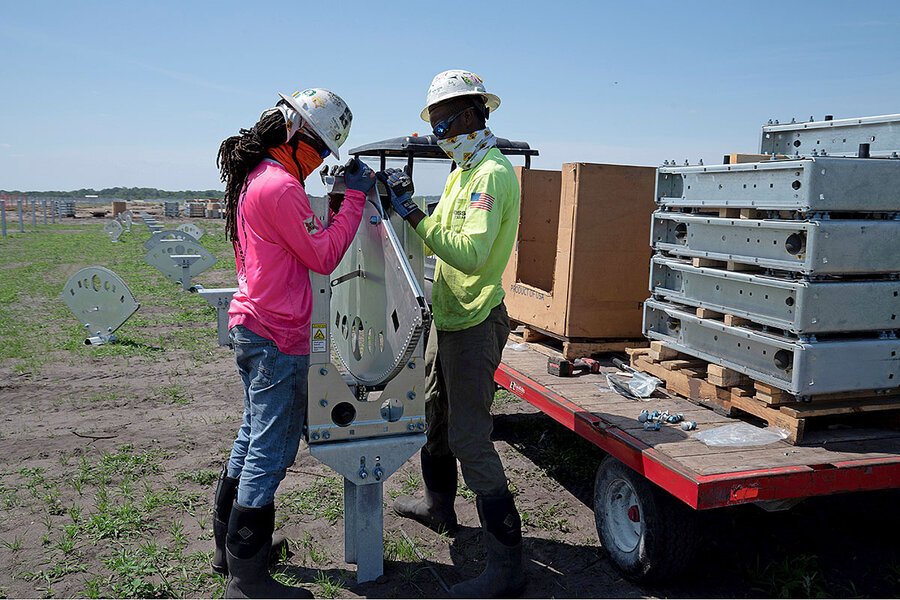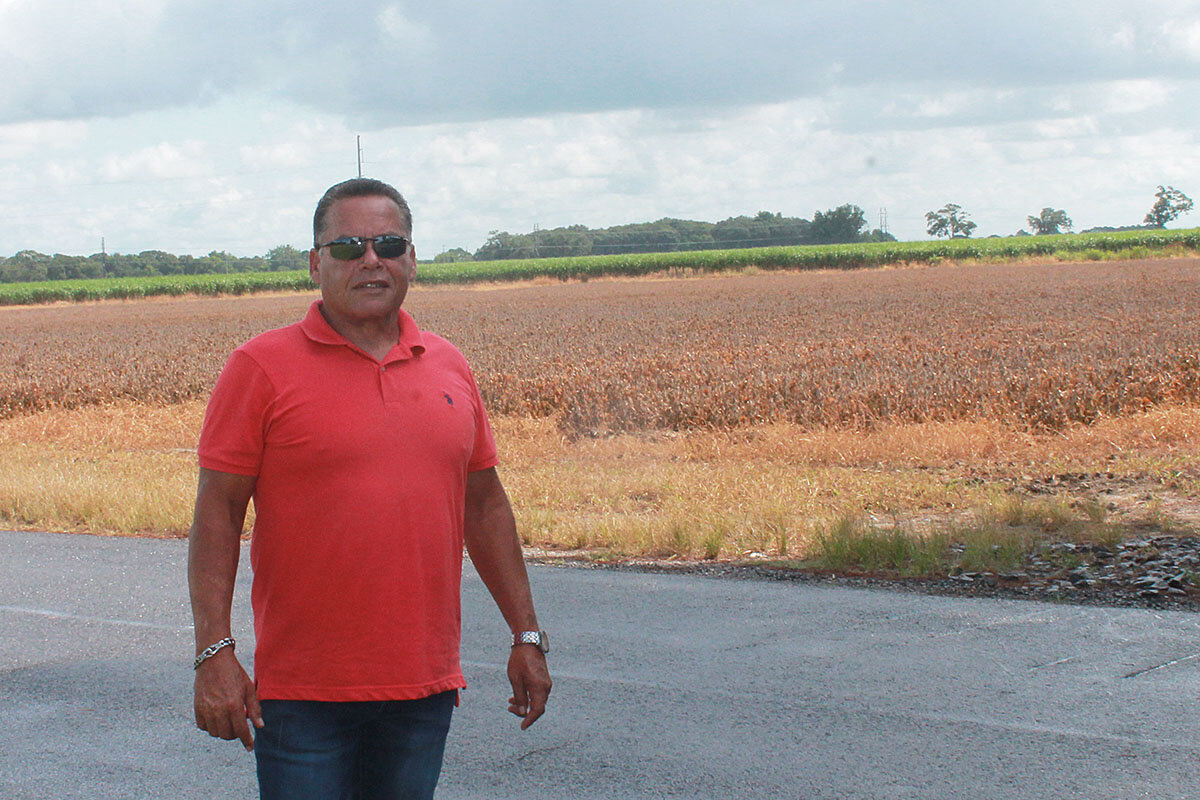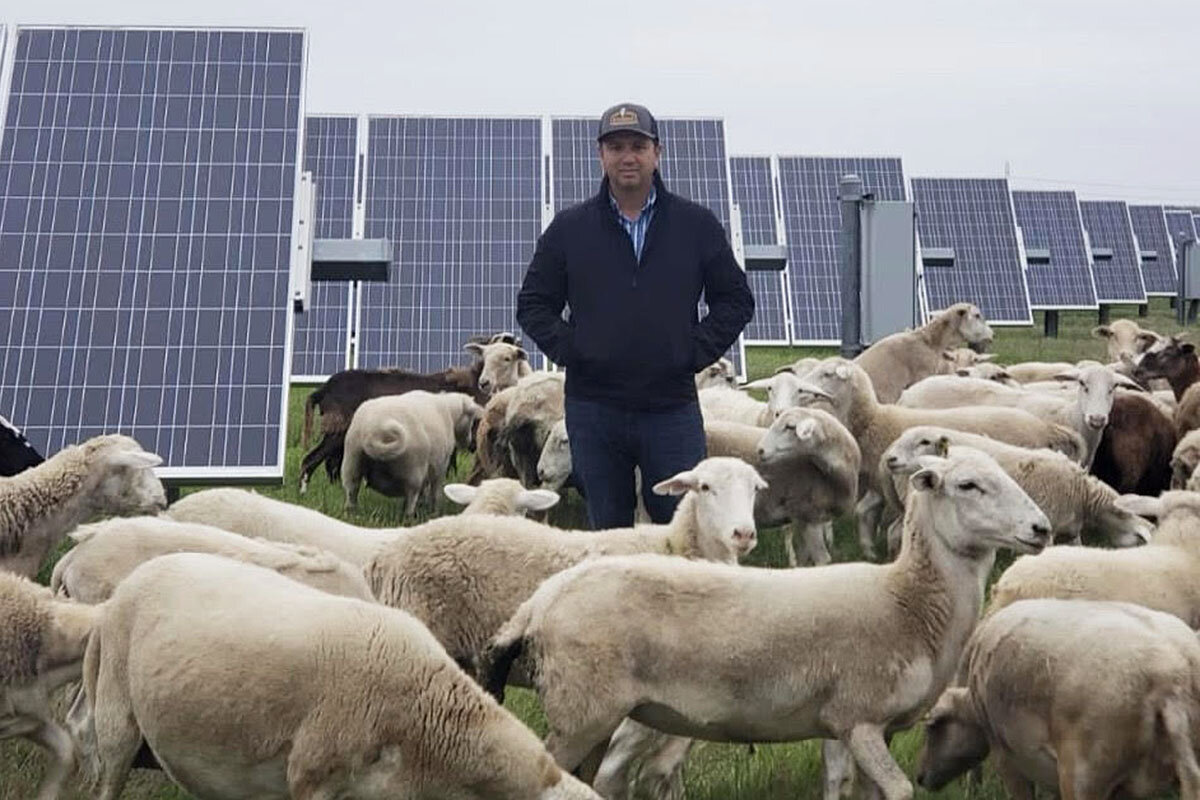Solar energy is a new cash crop for farmers – when the price is right
Loading...
| New Iberia, La.
Gregory Sigue can feel the sun on his back as he points to a soybean pasture behind his home. Though he’s only been outside in the Louisiana heat for a few minutes while he surveys his family’s 300 acres it leases to local farmers, ringlets of sweat have begun to collect around Mr. Sigue’s tanned neck.
Mr. Sigue’s family has been on the property in its part of south Louisiana dating back to his great-grandfather’s generation. In his youth alongside his siblings, he helped work the land.
“It taught me values,” he says.
Why We Wrote This
The transition toward renewable energy is creating a new kind of demand for rural land. Small farmers hope it can be a win-win trend – benefiting the environment and their own security.
A winding career path included time in California as an ironworker and, later, working on several green energy projects in that state. It was there, Mr. Sigue says, that a flash of inspiration came. He had always planned to return to south Louisiana with the intention of maintaining his family’s land. Why not develop a utility-scale solar project on the family’s cropland?
He is now pursuing his dream, in parallel with a rising number of U.S. farmers who are opening their thought to growing solar energy alongside crops. It’s an idea with big promise at a time of rising focus on climate change and the need to transition away from fossil fuels. But Mr. Sigue’s tale also indicates the challenges some farmers face. So far, the energy companies he has talked to as possible partners aren’t offering as much money as he can get leasing land to other local farmers.
But for many farmers, a land use revolution is already underway.
“In some regions, there is huge excitement for many landowners, with the opportunity to have a solar project on their land, because it does give them sort of a guaranteed source of revenue” that often beats their traditional income per acre, says Jordan Macknick, the lead energy, water, and land analyst at the National Renewable Energy Laboratory.
States creating incentives
Spurring it on are local policies and rising demand from energy companies that need places to build. States such as Massachusetts, Michigan, Colorado, California, Maine, Illinois, and Virginia have amended zoning laws for cropland solar projects, as well as offered tax rebates in some cases.
“Farmland serves as almost a perfect location for solar developers wanting to develop these utility-scale, ground-mounted solar projects,” Dr. Macknick says. “Farms are flat; farms have access roads; farms have access to electric transmission lines. They are an ideal setting.”
Projects such as these often come in one of two forms: solar installations and agrivoltaics.
An example of a solar installation would be similar to what Mr. Sigue is attempting to develop on his property, with solar panels mounted to the ground, and only gravel or grass in between. Meanwhile, other landowners are opting into agrivoltaics, which involves agriculture, including built-in pollinator habitats, sheep grazing, and planting crops underneath solar panels.
A recent study by researchers at Oregon State University found that if America’s farmers could share just 1% of their farmland for clean power – about 13,000 square miles – it could produce as much as 20% of the country’s electricity, renewably.
In the minds of many farmers, meanwhile, the benefits of such solar projects are hard to ignore.
Where sheep may safely graze
Ely Valdez, the founder and CEO of EVA Ranch and Solar Farm Services in San Antonio, is among them. Back in 2015, Mr. Valdez and his family began raising sheep as a hobby. Their herd was small at first. Mr. Valdez was working in the oil and petroleum industry at the time, but his job security ebbed and flowed with the price per barrel.
Like Mr. Sigue, Mr. Valdez had an idea when he noticed his neighbor across the road had begun developing a 100-acre solar project. He mentioned to the landowner that he had seen sheep grazing solar farmland on social media and offered to do the same. Mr. Valdez named his price, realizing that there was a profit to be made in the venture, and then he and the landowner next door set about placing 27 sheep on the property.
That was six years ago. Today, the Valdez family has nearly 900 sheep grazing more than 1,000 acres across three sites – three in San Antonio, and the other in nearby Somerset, Texas. It’s also diversified its business to include ground maintenance for large-scale solar sites across Texas, including washing solar panels and fixing roads going into the property.
“It went from an idea of ‘what if’ to a small family-owned business,” Mr. Valdez says.
Today, much to his surprise, Mr. Valdez considers himself a full-time farmer and solar grazer.
“We’re not landowners; we just offer the service, but I think it’s a win-win for both ways,” Mr. Valdez says of their operation. “We call it sheep paradise. They have food and shade all day.”
Selling or leasing the land?
For some small-scale agriculturalists, the matchmaking opportunity between their land and solar energy is ideal as they inch their way into retirement, too. The average age for the country’s farmers has increased by about a decade since 1978. Today, about one-third of America’s 3.4 million farmers are at least 65 years old, according to data compiled annually by the United States Department of Agriculture.
And projects such as what Mr. Sigue is attempting to install on his family’s land could potentially serve as an economic lifeline for modest-scale farmers who are struggling to compete in an increasingly consolidated industry. Today just 36% of all U.S. cropland is operated by midsize farms (100 to 999 acres), down from 57% in 1982, according to USDA data.
Mr. Sigue says one energy company offered just $400 per acre to lease and build a solar project – the same offer the company offered neighboring landowners, he later learned, but far below the $650 per acre he’s making by leasing it to local farmers. From there, each company he approached gave him an ultimatum if they were to work together: Lease the land for under market price, or sell it to the company for its own solar development.
Mr. Sigue balked at the idea. In no way did he intend to hand over his family’s property after their lifelong investment in it. He knows it’s a feat for a Black Creole family in the South, like his, to hold onto its land for as long as they have. By some estimates, Black Americans lost about 80% of the land acquired during the post-Civil War Reconstruction era due to a predatory federal loan system and other forms of discrimination, including racist violence.
Revenue isn’t the only hurdle for farmers. Neighboring landowners sometimes decry the aesthetic changes on the land. With overall farm acreage in decline due to factors like rising operating costs, depressed crop prices, and water shortages, some argue for caution in the land use transformation.
“The last thing you want to do is have solar and agriculture competing, even in a country like the U.S. that has something like two-thirds of our land is agricultural,” says Oscar Serpell, a researcher at the University of Pennsylvania’s Kleinman Center for Energy Policy. “Avoiding that competition is going to be essential both for preserving food production and for promoting solar development and wind development, and any other kind of renewable development.”
“It’s about creating that wealth here”
For his part, Mr. Sigue sees the opportunity for clean power, cropland, and jobs to coexist happily. He remembers the heyday of his family’s farming lifestyle. Their family worked hard and were pillars in the community, he says. When their farm was doing well, the people of New Iberia benefited.
It’s about keeping Louisianans’ money in Louisianans’ pockets, Mr. Sigue says. He worries that if large corporations begin developing their own cropland solar projects, then money that is desperately needed in a low-income state like Louisiana will be exported someplace else.
“If you offer opportunity to Louisianans first, then guess what? It’s about creating that wealth here and the wagon wheel of different effects that can stem off from that,” Mr. Sigue says. “There hasn’t been an opportunity this lucrative since they started drilling for oil and gas in Louisiana.”







